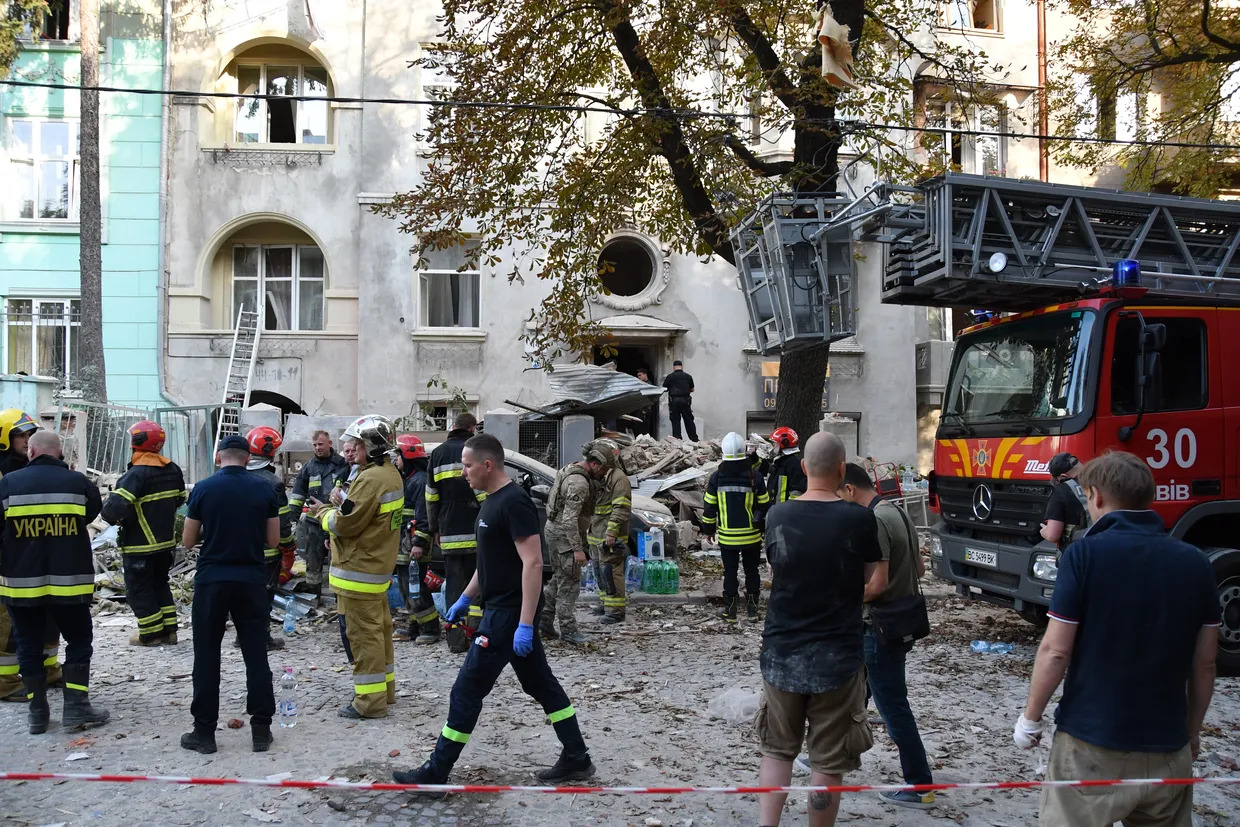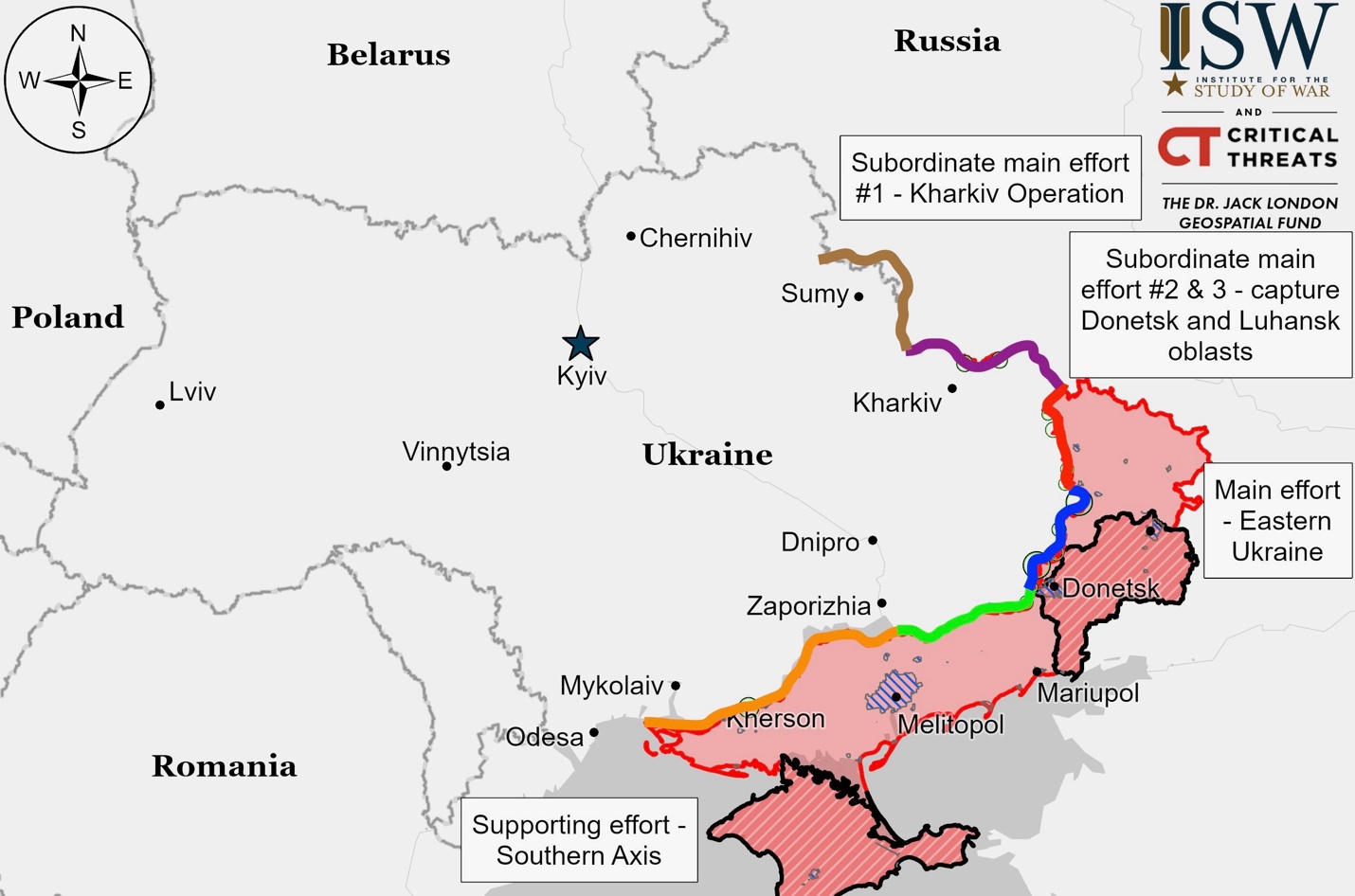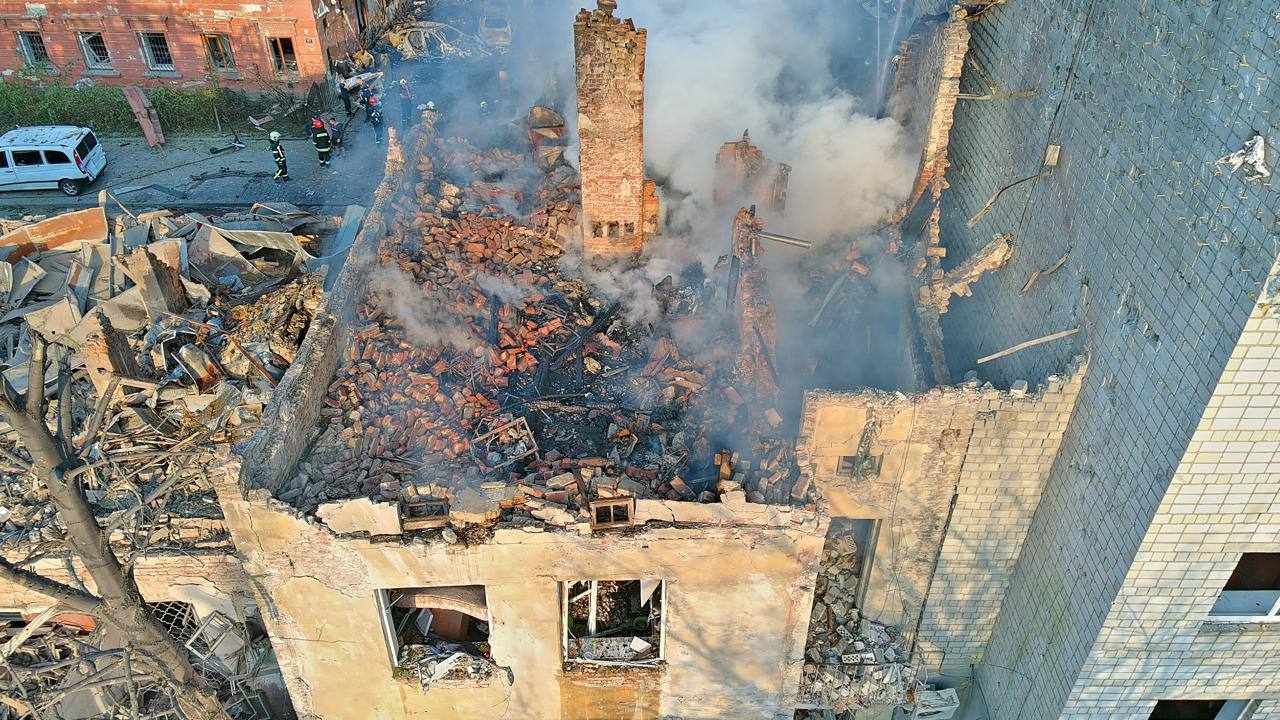Summary of the day: Russia launched another combined drone and missile strike on civilian infrastructure in Lviv and Kryvyi Rih, while reportedly advancing near Pokrovsk and Donetsk City. Ukrainian forces made marginal advances in Kursk Oblast and regained positions west of Donetsk City. International developments include Russia’s apparent efforts to evade Western sanctions through countries like India, Serbia, and China, while Germany announced plans to provide additional air defense systems to Ukraine. Amidst these events, Ukrainian authorities are investigating reports of Russian war crimes and have announced changes in senior cabinet positions.
Picture of the day:
 Rescuers work amid rubble at the site of a Russian missile strike in Lviv, Ukraine. The attack killed at least seven civilians and injured 64. (Mykola Tys/Global Images Ukraine via Getty Images)
Rescuers work amid rubble at the site of a Russian missile strike in Lviv, Ukraine. The attack killed at least seven civilians and injured 64. (Mykola Tys/Global Images Ukraine via Getty Images)
What Can I Do To Help Ukraine? This is a question I receive all the time. We at Transform Ukraine are building longer-term housing for internally displaced Ukrainians. Visit Rebuild Ukraine for how you can assist in housing a Ukrainian family displaced by the war.
Situation On The Land, Sea, and Air in Ukraine
The Russian Ministry of Defense claimed that its forces repelled four Ukrainian naval drones and shot down one aerial drone over the northwestern Black Sea. They also reported that Russian Black Sea Fleet helicopters destroyed four more Ukrainian naval drones heading towards Crimea.
Ukraine’s Defense Ministry confirmed the use of “dragon drones” against Russian forces. These drones drop fiery, white-hot metal on enemy positions. Footage shows their deployment in the Kharkiv sector by Ukraine’s 42nd Mechanized Brigade. The drones are reportedly equipped with thermite munitions, capable of burning at over 2,000 degrees Celsius and melting through some armored vehicles. This innovation adds to Ukraine’s drone arsenal, which has been crucial in striking Russian targets throughout the invasion. While effective, these weapons can cause severe injuries. Both Ukraine and Russia have heavily invested in drone technology during the conflict, changing modern warfare tactics.
Ukrainian military observer Kostyantyn Mashovets assessed that Belarus currently lacks the capability to invade Ukraine. He noted two Belarusian operational-tactical groups in Gomel Oblast, “Viking” and “Volat,” with a combined force of about 3,000 personnel. Additionally, around 1,000 Russian personnel are deployed with these groups. Mashovets concluded that this joint force is insufficient for a sustained invasion of Ukraine, aligning with previous assessments of the low likelihood of a Belarusian invasion.

Ukrainian Operations in the Russian Federation – Initiative Ukraine
Ukrainian forces made small advances in Kursk Oblast amid ongoing fighting in the Ukrainian salient. They reportedly advanced southeast of Durovka and along the 38K-030 road near Korenevo. Russian forces withdrew from Malaya Loknya. Clashes continued near Cherkasskoye Porechnoye and Martynovka. Various Russian units, including airborne and naval infantry, are operating in the area.
Kharkiv Front – Initiative Russia
Limited fighting continued in northern Kharkiv Oblast, with no confirmed frontline changes. Clashes were reported in Vovchansk, Lyptsi, and Hlyboke. Russian forces near Hlyboke were put on alert to counter Ukrainian drones. Russian units are still operating near Lukyantsi, north of Kharkiv City.
Luhansk Front – Initiative Russia
Russian forces continued attacks along the Kupyansk-Svatove-Kreminna line without confirmed advances. They targeted areas near Synkivka, Hlushkivka, Stelmakhivka, Pishchane, Berestove, Lozova, Myasozharivka, Druzhelyubivka, Novosadove, Nevske, Makiivka, Hrekivka, and Torske. Russian anti-tank units are reportedly active in the Kupyansk area.
Donetsk Front – Initiative Russia
Siversk
Russian forces launched offensive operations near Siversk without making confirmed advances. They conducted ground attacks in several nearby settlements, including Bilohorivka, Verkhnokamyanske, Ivano-Darivka, Spirne, Pereizne, and Rozdolivka. These attacks occurred in various directions around Siversk, but no significant territorial gains were reported.
Chasiv Yar
Russian forces attacked near Chasiv Yar but made no confirmed advances. They launched ground attacks in Klishchiivka, Andriivka, and Kurdyumivka.
Toretsk
Russian forces attacked near Toretsk without confirmed advances. They launched ground attacks in Druzhba, Niu York, Nelipivka, and Shcherbynivka. Russian sources claimed advances in eastern Toretsk and Druzhba, and the capture of Niu York, but these claims lack visual confirmation.
Pokrovsk
Russian forces advanced near Pokrovsk progressing south of Novohrodivka and west of Mykolaivka. They claimed to capture Karlivka, though this likely occurred earlier. Ukrainian forces repelled a Russian assault in the area. Attacks continued in several settlements including Vozdvyzhenka, Zelene Pole, Myrolyubivka, and others.
West of Donetsk City
Ukrainian forces reclaimed positions in eastern Maksymilyanivka, west of Donetsk City. They repelled a large Russian mechanized assault in the Kurakhove direction, damaging or destroying several armored vehicles. Russian forces continued attacks near Krasnohorivka and Heorhiivka.
Southwest of Donetsk City
Russian forces advanced southwest of Donetsk City progressing north of Paraskoviivka and along the Velyka Novosilka-Pavlivka highway near Prechystivka. They claimed to capture Prechystivka, but this lacks visual confirmation. Attacks continued near Kostyantynivka, Vodyane, Vuhledar, and Prechystivka. Russian sources reported increased artillery strikes on Vuhledar but cautioned against frontal assaults due to previous unsuccessful attempts.
Zaporizhia Front – Initiative None
Zaporizhia-Donetsk Border Area
A Russian source reported that Russian forces are trying to dislodge Ukrainian troops from positions north of Pryyutne, which is located south of Velyka Novosilka near the Donetsk-Zaporizhia border.
Zaporizhia Line
Fighting continued in western Zaporizhia Oblast near Robotyne, Novoandriivka, and Mala Tokmachka with no confirmed frontline changes.
Kherson (Dnipro River) Front – Initiative None
The Ukrainian General Staff reported Russian attacks in the Dnipro direction, likely referring to eastern Kherson Oblast and the Dnipro River delta islands.
Ukraine News
Russian forces conducted a combined drone and missile strike targeting civilian infrastructure in Lviv City and Kryvyi Rih. The attack involved various missile types and Shahed drones. Ukrainian forces intercepted several missiles and drones. In Kryvyi Rih, the strikes damaged civilian buildings and wounded up to six people. In Lviv City, seven civilians, including two children, were killed, and up to 188 buildings were damaged. These attacks on civilian targets violate international humanitarian law.
Ukrainian authorities are investigating a potential war crime near Toretsk, Donetsk Oblast, where Russian forces allegedly executed three Ukrainian prisoners of war. A video circulating on Telegram appears to show the incident, depicting Ukrainian soldiers surrendering and then being shot while face down on the ground. If verified, this act would violate the Geneva Convention, which prohibits harming soldiers who have surrendered. Ukraine’s Prosecutor General’s Office has launched an investigation into this event. (Russian War Crime)
Ukrainian officials announced significant cabinet changes, with several high-profile ministers submitting resignations, including Foreign Minister Dmytro Kuleba, Strategic Industries Minister Oleksandr Kamyshin, Deputy Prime Minister Olha Stefanishyna, and ministers for Justice (Denys Maliuska) and Ecology (Ruslan Strilets). Parliament voted to accept some resignations but failed to gather enough votes for others, such as State Property Fund head Vitalii Koval and Deputy Prime Minister Iryna Vereshchuk. Kuleba’s resignation is yet to be considered. This reshuffle, affecting over half the cabinet, aims to adjust Ukraine’s foreign and domestic policy priorities according to President Zelensky, who stated that these changes are necessary to strengthen the country.
David Arakhamia, head of Zelensky’s party in parliament, stated that dismissals and new appointments would occur on consecutive days. Oleksandr Merezhko, chair of the parliament’s foreign affairs committee, suggests these changes are in preparation for challenging times ahead, as Ukraine faces a difficult autumn and winter. Some officials, like Kamyshin, will transition to Zelensky’s office. The head of Ukraine’s state grid operator was also dismissed on September 2.
These changes come after months of speculation about potential replacements, though specific reasons for the resignations were not provided. Replacement candidates are expected to be announced soon. This reshuffle follows earlier dismissals of Infrastructure Minister Oleksandr Kubrakov and Agriculture Minister Mykola Solskyi in May.
Ukraine has successfully restructured its external debt, reducing it by $9 billion. The process involved exchanging $20.5 billion worth of Eurobonds for new bonds valued at $15.2 billion. This restructuring will decrease Ukraine’s debt payments by 93% over the next three years, saving over $11 billion. The deal also reduces debt servicing and repayment costs by 77% through 2033, saving nearly $23 billion. This agreement allows Ukraine to avoid default and continue financing its defense against Russia’s invasion while directing more resources to security and defense efforts.
The IMF is expected to pressure Ukraine to devalue its currency, cut interest rates, and raise taxes during the fifth round of negotiations for the Extended Fund Facility program. This $15.6 billion agreement provides Ukraine with regular financial aid installments. If approved, Ukraine could receive an additional $1.1 billion. However, Ukraine’s National Bank is reluctant to further devalue the hryvnia, which reached a historic low in July. The government also faces potential political backlash over tax increases. Despite foreign aid, Ukraine’s 2025 budget deficit is projected at $35 billion, with about $20 billion expected to be covered by EU and IMF assistance.
Innocent Victims Of War
The casualty count of civilians in the past 24 hours: (Russian War Crimes)
DEATHS: 9 INJURIES: 91
- In Lviv, seven civilians were killed, including a family of four, and 64 were wounded. Among the casualties were eight children. The attack damaged about 50 buildings near the central railway station, including schools and historical sites in a UNESCO buffer zone. Search and rescue operations in Lviv concluded by midday, with 47 people hospitalized, seven in critical condition.
- A Russian missile attack on Poltava on September 3 has killed 53 people and injured 298, with the death toll rising as rescue efforts continue. The attack targeted the Military Institute of Communications and a nearby medical facility, partially destroying the educational building. 25 people have been rescued, with 11 pulled from the rubble. Five more may still be trapped. The attack occurred during regular activities at the institute, not during any special events.
 The aftermath of a Russian attack against Lviv, Ukraine. (President Volodymyr Zelensky/Telegram)
The aftermath of a Russian attack against Lviv, Ukraine. (President Volodymyr Zelensky/Telegram)
Ukraine’s Allies
German Chancellor Olaf Scholz announced that Germany will provide Ukraine with 17 additional IRIS-T air defense systems by 2026, bringing the total to 24 systems, including both medium and short-range versions. Seven systems have already been delivered, with four more expected by the end of 2024. Scholz emphasized Germany’s continued support, noting that Berlin has become Ukraine’s second-largest military donor after the U.S. In a separate development, Ireland’s Prime Minister Simon Harris signed a ten-year support agreement with Ukraine during his visit to Kyiv, which includes diplomatic efforts and non-lethal military aid.
Irish Prime Minister Simon Harris visited Kyiv meeting with President Volodymyr Zelensky and signing a 10-year bilateral cooperation agreement. The deal includes 128 million euros in non-lethal military support and 40 million euros in humanitarian aid from Ireland this year. Ireland will provide mine clearance systems and support Ukrainian soldier training. Harris toured damaged areas in Kyiv Oblast, including Hostomel. Ireland’s total support to Ukraine since the war’s start now exceeds 380 million euros, excluding lethal aid due to Ireland’s neutrality policy.
Life in Russian-Occupied Ukraine
International Atomic Energy Agency (IAEA) Director General Rafael Grossi visited the Zaporizhzhia Nuclear Power Plant (ZNPP). He described the situation as “very fragile” following reported damage to external power lines in August. Russian media used the visit to claim Ukrainian forces are endangering the plant, while Rosatom’s CEO urged the IAEA to report on alleged attacks. Grossi also met with Ukrainian President Zelensky on September 3, pledging increased nuclear safety assistance to Ukraine.
Russia News
Russian President Vladimir Putin visited Vladivostok in Primorsky Krai, where he inspected the Primorsky Flotilla of the Pacific Fleet.
The International Monetary Fund (IMF) reportedly plans to send its first mission to Russia since the full-scale invasion of Ukraine began. The mission, led by Jacques Miniane, will start online and potentially visit Moscow in October. This would be the first IMF mission to Russia since 2019. Ksenia Yudaeva, a sanctioned former Russian Central Bank official, is set to replace Aleksei Mozhin as Russia’s IMF Executive Director in November, initially working from Moscow due to U.S. sanctions.
Russian Mobilization and Defense Industrial Base
Russian Deputy Defense Minister Anna Tsivileva met with Ulyanovsk Oblast Governor Alexei Russkikh to discuss support for local veterans of the Ukraine war. Tsivileva emphasized improving military medical facilities, providing social guarantees for servicemembers, and building housing for the 104th Guards Airborne Division and their families in Ulyanovsk Oblast. This meeting showcases the Russian Ministry of Defense’s efforts to address its obligations towards veterans.
Russia’s Allies
Russia is reportedly working with India, Serbia, and China to evade Western sanctions. A leaked plan from Russia’s Industry and Trade Ministry suggests efforts to secure critical electronic components, potentially through facilities in India. This strategy aims to use Indian rupees from increased oil sales to acquire sensitive dual-use electronics, supporting Russia’s defense industry despite sanctions.
Russian President Vladimir Putin met with Serbian and Chinese officials at the Eastern Economic Forum in Vladivostok. Serbia pledged not to impose sanctions on Russia or allow anti-Russian actions on its territory. Putin also discussed enhancing economic cooperation with China and Mongolia, although some foreign companies are becoming hesitant to work with Russia due to potential Western secondary sanctions.
Controlling the Narrative and Russian Propaganda
Ukrainian officials are combating Russian efforts to undermine Ukraine’s stability. The Ukrainian Kharkiv Group of Forces warned that Russia is using the recent strike on Poltava City to demoralize Ukrainians. The Security Service of Ukraine (SBU) reported on September 3 that it detained two IT specialists who aided Russian bot farms in Poltava Oblast and Transcarpathia. These bot farms were conducting information operations aimed at destabilizing Ukraine and discrediting its military.
The U.S. launched a major crackdown on alleged Russian election interference, with the Department of Justice seizing 32 internet domains used in Russian government-linked information campaigns. These campaigns aimed to reduce support for Ukraine, promote Russian interests, and influence voters in the U.S. and other countries. The action includes sanctioning high-profile Russian propagandists and introducing new visa restrictions. The U.S. Treasury Department designated 10 individuals and two entities as part of Russia’s “Doppelganger” propaganda campaign, including RT Editor-in-Chief Margarita Simonyan. The Justice Department indicted two RT employees and alleged that Russian firms were directed by Putin’s aide Sergey Kiriyenko to covertly spread propaganda. Senior Russian officials, including Sergei Kiriyenko from the Presidential Administration, reportedly directed Russian companies to use these domains for social media posts to influence U.S. policy and elections. The State Department designated several Russian state-run media companies as foreign missions.
Source Material
Institute for the Study of War – understandingwar.org
The Kyiv Independent – kyivindependent.com
Kyiv Post – kyivpost.com
